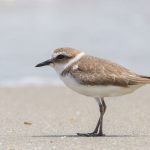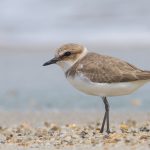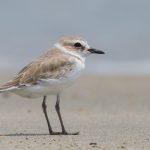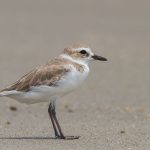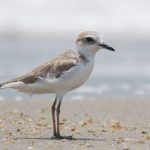Every autumn, at the shoreline of the reclaimed land next to Changi Airport, waders or shorebirds come to escape the harsh winter up north. They stay a few months before returning home to breed during springtime.
Among them is a species currently called Kentish Plover (Charadrius alexandrinus). Yet on closer examination, there are two distinct looking forms of this species mingling there. In a series of papers and articles(1,2,3) in the reference section below, the story unfolds about the rediscovery of the White-faced Plovers or Swinhoe’s Plovers that winters together with the more commonly recognised Kentish Plovers. The gist of these papers (which is worth reading for background information) is that the Swinhoe’s Plovers were ‘lost’ and found again, and when carefully observed are clearly different based on morphological (shape) and behavioural ground, and that their breeding region differs as well compared to the Kentish Plovers. The articles suggest that these plovers are possibly two species.
Yet, despite these publications, the Swinhoe’s Plover is still currently regarded as a subspecies of the Kentish Plover. Why it that? And will that change in the future?
A newer paper came out in 2011 on the status of the Kentish and the Swinhoe’s Plover again4. In it, scientific evidence based on genetic analysis suggest that these two very different looking birds are too alike genetically to be considered as separate species. This is somewhat akin to how in the dog world, the Chihuahuas and St. Bernard though very different in looks, size and behaviour, are very much the same species, as the genetic material that make them different are tiny compared to what make them alike.
Since the 1980s taxonomists have increasingly relied on genetic analysis as a new tool to sort our natural world, where in the past they relied on basic anatomical features to do so. There in fact have been a revolution of sorts as more and more species come under the radar of the modern-day taxonomists. But what does that really mean?
The Human Genome Project which aimed to sequence the entire human genome was started in the 1990s and completed in 2003 at the cost of 3 billion dollars, for which we decoded close to 3 billion bases of the human genetic blueprint.
So how could it be that the effort on birds started before then in 1980s? Well, there is a misconception that when we currently do genetic analysis on a bird, we must be studying the entire genome of the bird. Instead what usually happens is that we study small fragments of their genetic material, at a few selected location within the genome that either encode specific genes, or are good genetic markers. These target areas although limited, can separate species apart rather reliably. They are good but rough guides. The more differences there are in these target areas, the more distant both species are taxonomically, and vice versa.
For the Kentish Plovers and Swinhoe’s Plovers, what is striking is that they have very similar DNA sequences in those target areas in what we have looked at so far, compared to the much bigger differences between these specimens and other studied plovers such as the Malaysian Plovers or Javan Plovers. This mean they are very close genetically compared to the other plovers.
To get to the actual differences between these two closely related plovers, perhaps we need to look at their entire genome instead. Is that even feasible? As the cost of sequencing of an entire genome has dropped from $3 billion in 2003 to closer to $1,000 today due to advances in technology, the answer is that we are already starting to do so. But such projects are still in their infancy. And just because we have obtained much more data, doesn’t mean we know what they represent. No doubt we will get there one day, and taxonomists will have better understanding of what makes a species a species, and may seek to redefine once again the order of the natural world differently than now.
Where does that leave these two plovers? For now, genetically they seem more like subspecies. But in all matters of classification, human or plover interest may trump all. For example, since the Swinhoe’s Plovers can be seen as a more borderline case, and their numbers are declining as habitats are destroyed, a more conservation-minded organization may see it fit to upgrade it to a full species sooner rather than later. After all, a unique species is probably more worth saving that a subspecies in most people’s mind. So there you go!
Below is a photo gallery of the two said plovers, taken at Changi coast in 2011. Thanks to my friend who managed to get security clearance to the now restricted place. A new airport runway is coming soon, and so the plovers must soon find another wintering ground elsewhere.
Photo Gallery:
- A non-breeding plumage Kentish Plover at Changi coast.
- Swinhoe’s Plover. The difference in posture, leg colour, bill size, head shape and plumage colour is evident.
- A different non-breeding Kentish Plover. The leg is darker, the plumage is more evenly coloured and darker, the bill is smaller and it has a more horizontal stance. Legs are dark.
- The Swinhoe’s Plover plumage is lighter and less evenly coloured. Slight pinkish tones in the legs, and the bill is heavier. Also note that the posture is more upright.
- Another picture of a non-breeding plumage Swinhoe’s Plover.
- A front view of the Swinhoe’s Plover showing a lot of whites, hence their alternate name, the White-faced Plover.
- Another non-breeding plumaged individual Swinhoe’s Plover.
References:
1. Surfbird: Malaysia mystery Plover (Bakewell & Kennerley)
2. Forktail: Rediscovery of a long-lost Charadrius plover from South-East Asia (Kennerley, Bakewell & Round, 2004)
3. Birding Beijing blog: Swinhoe’s (White-faced) Plovers
4. Conflict between Genetic and Phenotypic Differentiation: The Evolutionary History of a ‘Lost and Rediscovered’ Shorebird (Rheindt et al, 2011)
